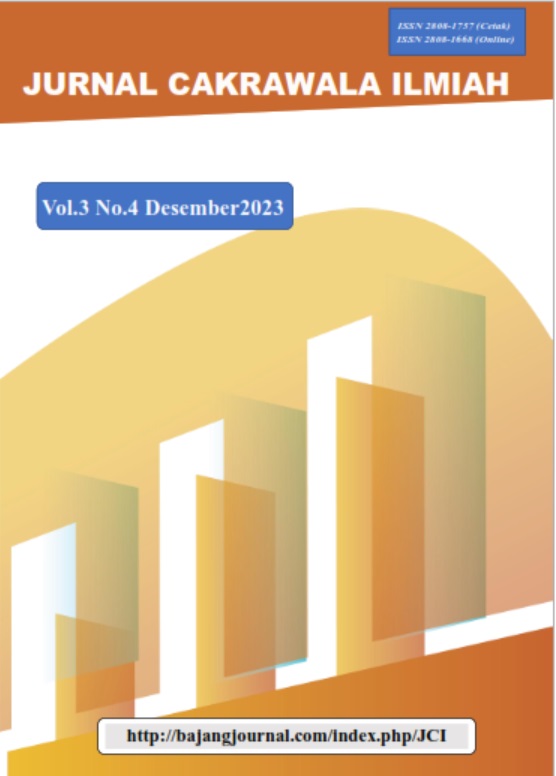NEUROMYTH: BETWEEN MYTH AND REALITY IN PHILOSOPHICAL PERSPECTIVE
Keywords:
neuromyth, philosophy, brain, neuroscienceAbstract
Neuromyths are erroneous beliefs about the brain and how it works. Neuromyths often appear in mass media, popular literature, and even in formal education. Neuromyths can have negative impacts, such as causing diagnostic and therapeutic errors, as well as hindering research and development in the field of neuroscience.
In this paper, the author will discuss neuromyths from a philosophical perspective. The author will review how neuromyths emerge and develop, as well as how neuromyths can be criticized from a philosophical perspective. The author will also discuss the implications of neuromyths for society and education.
References
Arslan, Y., Gordon, R., & Tolmie, A. (2022). Teachers’ understanding of neuromyths: a role for educational neuroscience in teacher training. In Impact. discovery.ucl.ac.uk. https://discovery.ucl.ac.uk/id/eprint/10156236/1/Tolmie_Issue paper-Chartered College of Teaching.pdf
Bailey, R. P. (2018). The prevalence of pseudoscientific ideas and neuromyths among sports coaches. Frontiers in Psychology, 9. https://doi.org/10.3389/fpsyg.2018.00641
Deligiannidi, K., & Howard-Jones, P. A. (2015). The neuroscience literacy of teachers in Greece. Procedia-Social and Behavioral …. https://www.sciencedirect.com/science/article/pii/S1877042815011921
Düvel, N., Wolf, A., & Kopiez, R. (2017). Neuromyths in music education: Prevalence and predictors of misconceptions among teachers and students. In Frontiers in Psychology. frontiersin.org. https://doi.org/10.3389/fpsyg.2017.00629
From neuromyth to reality. (2010). In New Scientist (Vol. 208, Issue 2780, p. 3). Elsevier BV. https://doi.org/10.1016/s0262-4079(10)62368-8
García, A. S. (2022). Dialogue with Latin American Teachers: Beliefs About Neuroscience and Education. In Cognitive Sciences and Education in Non-WEIRD Populations: A Latin American Perspective (pp. 25–40). https://doi.org/10.1007/978-3-031-06908-6_3
Geake, J. (2008). Neuromythologies in education. Educational Research. https://doi.org/10.1080/00131880802082518
Gleichgerrcht, E., Luttges, B. L., & ... (2015). Educational neuromyths among teachers in Latin America. Mind, Brain, and …. https://doi.org/10.1111/mbe.12086
Grospietsch, F., & Mayer, J. (2020). Misconceptions about neuroscience–prevalence and persistence of neuromyths in education. In Neuroforum. degruyter.com. https://doi.org/10.1515/nf-2020-0006
Gurdis, A. (2020). Neuromyths: What We Know, and What We Think We Know. In … . org/2020/10/neuromyths-what-we-know-andwhat …. chargedmagazine.org. http://chargedmagazine.org/2020/10/neuromyths-what-we-know-and-what-we-think-we-know/
Horvath, J. (2018). On the irrelevance of neuromyths to teacher effectiveness: Comparing neuro-literacy levels amongst award-winning and non-award winning teachers. Frontiers in Psychology, 9. https://doi.org/10.3389/fpsyg.2018.01666
Howard-Jones, P. (2017). Neuromyths. IBE-UNESCO/IBRO Science of Learning Briefings. UNESCO International Bureau of Education. https://eric.ed.gov/?id=ED600854
Jeyavel, S., Pandey, V., Rajkumar, E., & ... (2022). Neuromyths in education: prevalence among south Indian school teachers. In Frontiers in …. frontiersin.org. https://doi.org/10.3389/feduc.2022.781735
Kalbfleisch, M. (2015). Educational neuroscience, constructivism, and the mediation of learning and creativity in the 21st century. In Frontiers in Psychology (Vol. 6). https://doi.org/10.3389/fpsyg.2015.00133
Karakus, O., Howard-Jones, P. A., & Jay, T. (2015). Primary and secondary school teachers’ knowledge and misconceptions about the brain in Turkey. Procedia-Social and Behavioral …. https://www.sciencedirect.com/science/article/pii/S1877042815009106
Knowland, V. C. P., & Thomas, M. S. C. (2020). Neuro-myths in the classroom. … You and Your Teachers Need to …. https://books.google.com/books?hl=en&lr=&id=fGYNEAAAQBAJ&oi=fnd&pg=PA51&dq=neuromyth&ots=i9ZjznBB7t&sig=tK9-FtvjiUh0R6sUblhRLTerkx4
Lawrence, B. C., Ntelioglou, B. Y., & Milford, T. (2020). It is complicated: Learning and teaching is not about ’learning styles. In Everything You and Your …. frontiersin.org. https://doi.org/10.3389/frym.2020.00110
Lethaby, C., & Harries, P. (2017). Do You Believe in “Neuromyths”? In TEAL News. bcteal.org. https://bcteal.org/docs/TEAL-News-Winter-2017.pdf#page=14
Maisarah, A., Alfian, M., & Amran, M. S. (2023). Kajian Pengetahuan dan Kepercayaan Mitos Otak serta Aplikasinya dalam Konteks Pendidikan ( A Study of Knowledge and Beliefs of Brain Myths and its Application in Education Context ). 8(4).
Neuromyths, B., & Mind, B. (2011). Neuroscience Bases of Learning. Learning and Cognition. https://books.google.com/books?hl=en&lr=&id=j-loT41ln34C&oi=fnd&pg=PA9&dq=neuromyth&ots=UTLhaXFygK&sig=dwtUjXYM10NIw5owF84KJMstH2c
Papadatou-Pastou, M., Haliou, E., & Vlachos, F. (2017). Brain knowledge and the prevalence of neuromyths among prospective teachers in Greece. In Frontiers in psychology. frontiersin.org. https://doi.org/10.3389/fpsyg.2017.00804
Papatzikis, E. (2017). Neuromyths in education and development: A comprehensive approach. In European Scientific Journal, ESJ. core.ac.uk. https://core.ac.uk/download/pdf/236411267.pdf
Pei, X., Howard-Jones, P. A., Zhang, S., Liu, X., & ... (2015). Teachers’ understanding about the brain in East China. Procedia-Social and …. https://www.sciencedirect.com/science/article/pii/S1877042815011507
Ruhaak, A. E. (2018). The Prevalence of Educational Neuromyths Among Pre-Service Special Education Teachers. Mind, Brain, and Education, 12(3), 155–161. https://doi.org/10.1111/mbe.12181
Shin, D. D. (2022). Beyond left and right: Learning is a whole-brain process. Theory into Practice, 61(3), 347–357. https://doi.org/10.1080/00405841.2022.2096386
Stephenson, J. (2008). Neuromyths and special education. Special Education Perspectives. https://doi.org/10.3316/aeipt.173507
Tardif, E., Doudin, P. A., & Meylan, N. (2015). Neuromyths among teachers and student teachers. Mind, Brain, and Education. https://doi.org/10.1111/mbe.12070
Teske, J. A. (2006). Neuromythology: Brains and stories. Zygon®. https://doi.org/10.1111/j.1467-9744.2006.00732.x
Tovazzi, A., Giovannini, S., & Basso, D. (2020). A new method for evaluating knowledge, beliefs, and neuromyths about the mind and brain among Italian teachers. Mind, Brain, and Education. https://doi.org/10.1111/mbe.12249
Turner, M. (2016). Preface to “neuromythology.” In Practical Neurology. ora.ox.ac.uk. https://ora.ox.ac.uk/objects/uuid:c294b2cd-2df5-42c0-b9a3-d74759ffb847/files/me8dfba0aaf3f6c041232e1de5961ccc9
Tyler, K. L., & Rüegg, S. (2020). The neuromythology of Hashimoto encephalopathy: The emperor has no clothes. Neurology. https://n.neurology.org/content/94/2/55.extract
Warnke, P. C., Ostertag, C. B., & Hobbs, J. (2015). 196; Long-term Outcome After Stereotactic Cysto-Ventricular Shunt and Radiotherapy in Craniopharyngiomas—The Neuromythology of Aseptic Meningitis …. Neurosurgery. https://search.proquest.com/openview/6dccc018628d7cc46472164120067423/1?pq-origsite=gscholar&cbl=2046368
Weale, S. (2017). Teachers must ditch ’neuromyth’of learning styles, say scientists. In The Guardian.
Downloads
Published
How to Cite
Issue
Section
License
Copyright (c) 2023 Jurnal Cakrawala Ilmiah

This work is licensed under a Creative Commons Attribution-NonCommercial 4.0 International License.
















